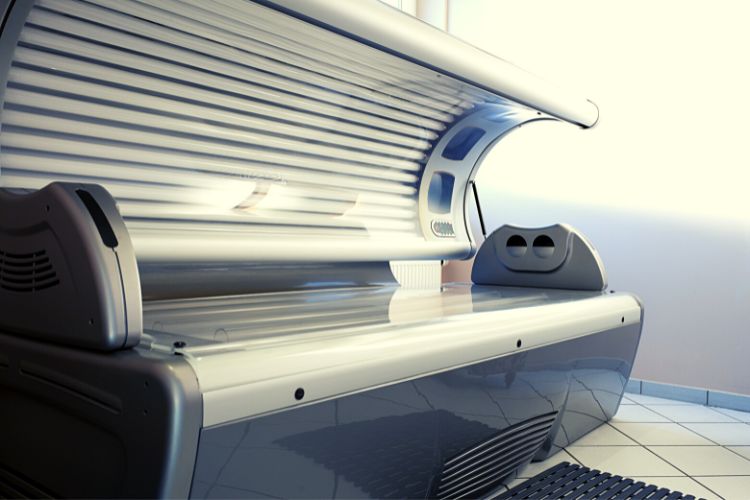Did you know that UV radiation from tanning beds can increase your risk of skin cancer, wrinkling, and other visible changes to your skin? Did you also know that the CDC, American Cancer Society, and National Institute for Occupational Safety and Health all warn against indoor tanning due to these risks? Did you know that if you are reading this article, then there is a good chance that you are considering using a tanning bed anyway?
Whether it’s because you think your risk of getting skin cancer is low or because you simply don’t care about the risks, there are some good reasons why tanning beds won’t work for everyone. If any of these reasons resonate with you – perhaps now, or at some point in the future – then perhaps now is not the time for indoor tanning. Let’s take a look at why.
You are currently using or have used tanning beds in the past.
You should always wear protective eyewear when tanning to prevent eye damage and skin discoloration. Eyewear should also be worn when around someone who is using a tanning bed, as the ultraviolet rays may cause eye damage as well. If you are at risk for eye diseases like macular degeneration, diabetic retinopathy, or glaucoma, you should not use a tanning bed.
Tanning beds emit ultraviolet rays that are known to cause skin cancer. They are especially dangerous for those at risk for skin cancer, such as fair-skinned people and those with a family history of the disease. According to the American Academy of Ophthalmology, tanning beds are known to cause eye damage and are not recommended for those at risk for eye diseases.
You are pregnant or you know that you are going to become pregnant soon.
Even if you are not actively trying to become pregnant, you have a higher risk of developing skin cancer if you are pregnant, especially during the first trimester. The risk is even higher if you have a family history of skin cancer or you have used a tanning bed in the past. If you do become pregnant and you regularly use a tanning bed, you are at a higher risk of getting skin cancer during your pregnancy.
If you have fair skin, you will have a higher risk of developing melanoma while you are pregnant because your melanin levels will be low. Unfortunately, melanomas are often found during pregnancy and can be extremely dangerous to both mother and child. If you are pregnant, talk to your doctor about ways you can protect your skin, especially if you regularly use a tanning bed. You can also avoid indoor tanning by wearing protective clothing and sunscreen when you are outdoors.
You have fair skin and you want to become darker, not lighter.
As mentioned above, if you have fair skin, you are at a higher risk of developing melanoma. On the other hand, if you have darker skin, you are at a higher risk of developing squamous cell carcinoma. Squamous cell carcinoma is the most common form of skin cancer and is almost always curable if it is caught early enough. If you have fair skin and you want to become darker, you can use a tanning bed to do so.
However, that doesn’t mean you are safe from the risks that come with indoor tanning. On the contrary, you are still at risk of developing skin cancers, albeit not as high of a risk as you would if you had darker skin. If you choose to indoor tan regardless, you should use sunscreen and protective clothing to protect your skin.
You are under the age of 18 or you know that you will be turning 18 soon.
As mentioned above, you are at a higher risk of developing skin cancer at any age if you regularly use a tanning bed. While skin cancers are usually curable when they are caught early, they can cause significant damage to your body before they are found. While adults are regularly treated for skin cancer, teens are often misdiagnosed due to their still-developing immune systems.
This can lead to serious complications, including the development of squamous cell carcinoma in areas like your palms, soles, and under your nails. Squamous cell carcinoma in these areas can be deadly because it is difficult to remove. If you are under 18 or know that you are going to be turning 18 soon, you should avoid indoor tanning at all costs. This advice is especially important if you have fair skin. You should wear sunscreen and protective clothing, even when you are indoors.
You have a family history of skin cancer or other significant health risks.
You may be at a higher risk of developing skin cancer even if you have not used a tanning bed. This is especially true if you have a family history of skin cancer. Even if you don’t have a family history of skin cancer, you may have other significant health risks that make indoor tanning unwise for you.
If you have a family history of skin cancer, you may have a genetic mutation that makes you more likely to develop skin cancer than a person without that mutation. You may also have a higher risk of developing skin cancer from indoor tanning due to other significant health risks like conditions that affect your immune system.
You want to increase your vitamin D levels.
If you are considering indoor tanning to increase your vitamin D levels, then you are at a high risk of developing skin cancers. While vitamin D is important for your health, you can get enough of it from spending time in the sun and by eating vitamin D-rich foods.
Vitamin D is also available in supplements, but doctors recommend that you take it in a smaller dose than what is found in a single indoor tanning session. If you want to increase your vitamin D levels, you can do so by spending time in the sun with sunscreen on or eating more vitamin D-rich foods. You can also take vitamin D supplements in smaller doses.
Conclusion
Indoor tanning is dangerous and can lead to serious health complications, including skin cancers. If you have fair skin, have a family history of skin cancer, have significant health risks, or want to increase your vitamin D levels, then you are at a higher risk of developing skin cancers from indoor tanning. If any of these reasons resonate with you – perhaps now, or at some point in the future – then perhaps now is not the time for indoor tanning.

